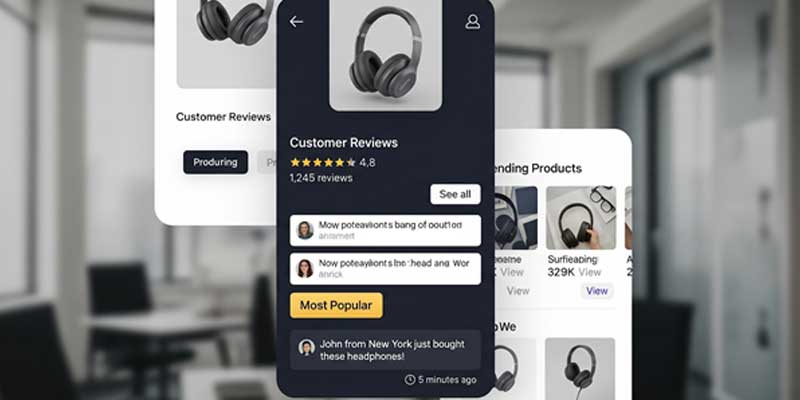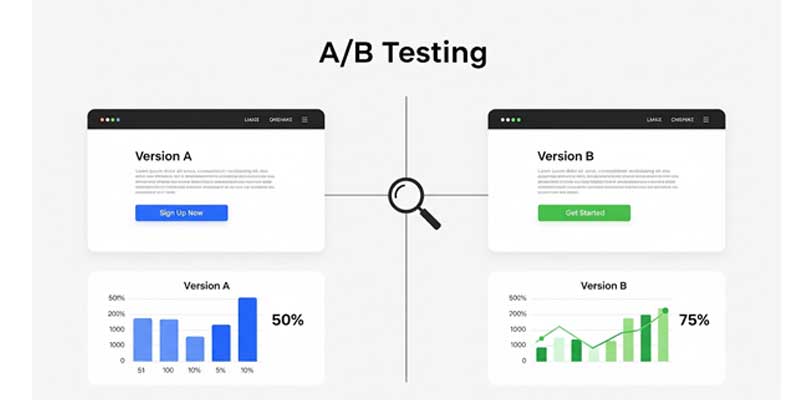

Website design elements are the building blocks that shape how a site looks, feels, and functions. From typography and color schemes to navigation menus and page speed, each element plays a role in guiding visitors, communicating your brand, and encouraging action.
These elements matter because they go far beyond aesthetics. A well-designed website improves user experience (UX) by making it easier for visitors to find what they need. It strengthens SEO by ensuring pages load quickly, perform well on mobile, and meet Google’s Core Web Vitals standards. And from a business perspective, thoughtful design drives trust, keeps people engaged longer, and directly impacts conversions.
Modern web design has moved into a new era—where AI-driven personalization, mobile-first layouts, and performance optimization are no longer optional, but expected. Businesses that embrace these trends gain a competitive edge, while outdated sites risk being ignored.
Miss even one of these critical website design elements, and your website could lose both traffic and conversions.
Website design elements are the core components that make up the structure, appearance, and usability of a website. They include everything from visual features like typography, color palettes, and imagery to functional aspects such as navigation, responsiveness, and loading speed. Together, these elements determine how users interact with your site and how search engines evaluate its quality.
In simple terms, website design elements are the building blocks of an effective online presence. When balanced correctly, they create a site that is not only attractive but also easy to use, search engine–friendly, and capable of turning visitors into customers.
Use clear sections (solutions, about us, resources, contact) and intuitive navigation on your site. What your business does and what problem it solves must be clear in the first few seconds. Strong, concise messaging that entices your target audience will help improve website traffic.
Give viewers valuable resources, such as whitepapers, case studies, or webinars, to get the contact information. Make these resources tastefully designed and accessible.
Make sure your forms are simple and have only a few fields. Avoid long, complicated fields and forms that will scare people away from completing specific desired actions. A live chat feature or a chatbot that can answer questions in real time can help visitors find solutions while engaging them with customer service.

Use testimonials and case studies showing successful partnerships between other businesses. Real reviews and customer success stories create trust.
Utilize industry certifications, awards, or associations with some organizations to build a strong image and consequently give the business credibility. Displaying security badges, especially for websites holding sensitive client information, so their visitors are assured that their information is secure.
Since most B2B customers search from mobile devices, the website needs to be responsive and look perfect on all devices. Faster web page loading improves the user experience and increases search rankings. This would reduce the bounce rate while increasing the possibility of improving conversions.
Add colors, typescript, or images reflecting your business identity. Your website design should look like your printed version of marketing materials.
Business photographs, infographics, or videos that market the business well can be utilized. Low-quality images, having been previously used by a string of businesses, are less likely to add that difference in service offering and need to be avoided.
The use of negative space with an ultra-clean minimalist design. Key messages and calls to action need to be drawn attention.
Personalize content on your website depending on your buyer personas or segment. It can be achieved in dynamic blocks of content or several pages for various segments or types of pain.
Your website needs to be comfortable to browse, and it should offer an intuitive navigation system and quick interfaces. Bad experience deters visitors and kills conversions.

Test web page elements like call-to-buttons, headlines, and images with your target audience and find out which one of them will respond better towards the conversion.
Use analytics tools like Google Analytics in order to track user activities. To identify weaknesses in a website, apply parameters such as the bounce rate, average time spent on a website, and conversion rate. Add social media share buttons so users can share your content right from your site, and that can increase brand visibility.
Publish real customer and partner feedback so people know what to expect from your company. It can also be in video form. This will help create credibility and help build a positive impression among your future customers.
Some B2B website design mistakes can hinder your marketing efforts, making it a bad user experience and may lead to a reduction in conversions. This can lead to missing some business opportunities. Here are some common design mistakes to avoid:
A website full of elements, heavy text, or busy graphics can be confusing to look at. Use a clean minimalist design with lots of white space. Keep it as simple and clear as possible so that your visitors can navigate to find what they need.
Visitors will lose interest in your content before it even loads if your website takes too long to load. A slow load time also negatively affects the SEO rankings. Optimize images, eliminate unused code, and apply caching for fast load times. Target a less than 3-second load time.
Visitors leave your site quickly if they do not immediately know what your company does or how it will solve their problems. Ensure that your value proposition stands out clearly on the front page.
If your website lacks clear and compelling calls to action, visitors will be unsure of what to do next, and therefore conversion opportunities will be missed. Use action-oriented, benefit-driven verbs like "Request a Demo" or "Get Started Today."
If contact information cannot be easily located or a way of getting in contact is not readily available, frustration gets built and fewer conversion opportunities are introduced. Make sure your contact information is listed on every page, preferably in the header or footer. There are also contact numbers, email addresses, a contact form, as well as live chat.
In case there are too many pop-ups, it may become annoying to visitors while damaging their experience when they are looking to navigate. Use pop-ups only in strategic situations, such as when the user is leaving your site. Ensure they are easy to close and of value for money, such as an offer or useful resource.
An old website with old content, broken links, or outdated product information is not very credible and may just send potential clients elsewhere. Update your content, blog posts, product offerings, and case studies regularly. A website must be kept fresh and relevant, which would then project a sense of an active business evolving.
Avoid the common mistakes mentioned above to create an effective B2B website design. You will have a user-friendly and professional-looking website, which leads to better B2B marketing results, helps build trust in the company, and, therefore, improves lead generation and conversion rates.
The digital landscape is evolving quickly, and staying ahead means adapting to the latest web design practices. In 2025, these advanced trends are shaping how websites engage users and perform online.
Artificial intelligence is transforming web design by tailoring experiences to individual users. From personalized product recommendations to adaptive landing pages, AI ensures visitors see the most relevant content, improving engagement and conversions.
Subtle animations, hover effects, and interactive icons create a more dynamic browsing experience. These micro-interactions guide user behavior, reduce friction, and make websites feel modern and intuitive without overwhelming the design.
Clean layouts, simple shapes, and reduced clutter continue to dominate. Semi-flat design blends minimalism with slight shadows and depth, making interfaces visually appealing while keeping usability front and center.
With smart assistants becoming mainstream, websites are shifting to support voice search queries and conversational user interfaces. Optimizing for natural language and structured data ensures your site remains accessible in this new search era.
Eco-friendly websites are gaining traction. Using green hosting providers, optimizing code for efficiency, and reducing unnecessary media not only cut carbon footprints but also improve site speed—a win for both the planet and user experience.
Common Mistakes to Avoid
Even with the best intentions, poor design decisions can hold a website back. Here are common pitfalls to steer clear of:
For quick reference, here’s a simple checklist to evaluate your website design:
Keeping this checklist in mind ensures your website remains modern, user-friendly, and search engine optimized.
Your website is an important asset for your brand. It is significant to have a powerful website to help in B2B marketing success, engage your audience, and increase sales. Bud, a web development agency in Bangalore, can help you create a striking website design with essential design elements for your website. To improve your website’s UX, Bud can help you with its digital marketing team and web development team and help you get the results you want.
What are the latest website design trends in 2025?In 2025, the most impactful trends include AI-driven personalization, micro-interactions, semi-flat minimalist design, voice search optimization, and sustainable web design practices. These trends focus on improving user experience, site performance, and accessibility.
Why is AI-driven personalization important for websites?AI-driven personalization helps deliver tailored experiences by analyzing user behavior and preferences. It boosts engagement, increases conversions, and makes websites feel more relevant to individual visitors.
Are micro-interactions really necessary in website design?Yes. Micro-interactions, such as hover effects or animated buttons, enhance usability by giving users feedback and making interactions smoother. When used wisely, they create a more engaging and modern user experience.
What common mistakes should be avoided in website design?Some of the most frequent mistakes include keyword stuffing, cluttered navigation, overusing animations, ignoring accessibility, and failing to adopt mobile-first design. These errors hurt both SEO and user experience.
How does minimalist and semi-flat design benefit websites?Minimalist and semi-flat design reduces clutter and focuses attention on key content. It improves readability, enhances navigation, and ensures that pages load faster—factors that positively impact SEO and conversions.
What is sustainable web design?Sustainable web design focuses on reducing a website’s environmental footprint. It includes practices like using green hosting, optimizing code, compressing media, and eliminating unnecessary scripts. These steps also improve site speed and performance.
How can I quickly check if my website has the right design elements?Using a checklist helps. Look for clear typography, brand-aligned colors, mobile responsiveness, fast loading speed, strong CTAs, SEO-friendly structure, and accessibility features. These essentials ensure your website is both user-friendly and search-engine ready.